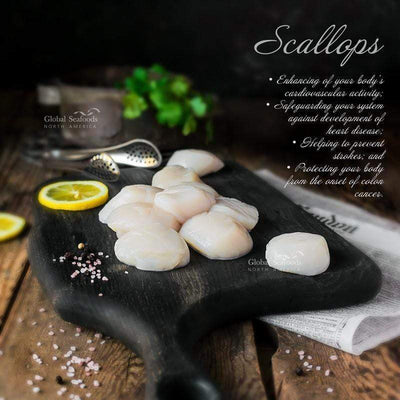Wild Scallops: A Culinary Guide for Seafood Lovers | Health Benefits, Cooking Tips

What Are Wild Scallops?
Wild scallops are a culinary delight cherished by seafood enthusiasts worldwide. Known for their tender texture, sweet flavor, and high nutritional value, wild scallops offer an exceptional seafood experience. In this comprehensive guide, we’ll explore everything you need to know about wild-caught scallops, from their origins and benefits to the best cooking techniques and sustainable sourcing options.
Whether you're a seasoned seafood connoisseur or a curious home cook, this guide will help you prepare and enjoy wild sea scallops like a pro.
What are Wild Scallops?
Wild scallops are a type of mollusk found in oceans across the globe. These mollusks feature a hard, fan-shaped shell that protects the tender, sweet meat inside. Unlike farmed scallops, wild scallops are harvested naturally from the open sea, giving them a unique flavor and firm texture that seafood lovers adore.
Want to try high-quality scallops? Check out our Jumbo Sea Scallops or Hokkaido Scallops for the best selection.
Where Do Wild Scallops Come From?
Wild sea scallops are found in oceans all over the world, from the chilly waters of Alaska to the warm shores of the Gulf of Mexico. They are harvested using a variety of methods, such as dredging, diving, and handpicking, ensuring that you get the freshest scallops possible.
For top-quality scallops, try our Alaskan Pink Scallops or Smoked Weathervane Scallops from sustainable sources.
The Taste of Wild Scallops: Why They’re a Seafood Favorite
Wild scallops offer a sweet, delicate flavor with a mild brininess that captures the essence of the ocean. Their tender, buttery texture melts in your mouth, making them a prized choice among chefs and home cooks alike. The flavor of wild scallops is often described as buttery or nutty, with a slight oceanic taste that pairs beautifully with various seasonings.
Nutritional Benefits of Wild Scallops
Wild scallops are a powerhouse of nutrients, making them not only delicious but also healthy. They are an excellent source of lean protein, omega-3 fatty acids, and essential vitamins and minerals, such as vitamin B12, magnesium, and zinc. Omega-3 fatty acids are especially beneficial for heart health, reducing inflammation, and supporting brain function.
How to Cook Wild Scallops: The Best Practices
Cooking wild scallops to perfection requires some knowledge of the best techniques. Follow these steps to ensure your wild sea scallops come out tender, flavorful, and perfectly cooked.
1. Choose the Freshest Wild Scallops
When shopping for wild-caught scallops, make sure to select those that smell fresh with no strong fishy odor. They should be firm to the touch and have a slightly springy texture.
For the freshest scallops, browse our Jumbo Sea Scallops or Hokkaido Scallops.
2. Preparation is Key
Before cooking, pat the scallops dry to remove any excess moisture. Drying them ensures that they sear beautifully in the pan, developing a golden-brown crust. Moist scallops are more likely to steam, which can result in a less desirable texture.
3. Sear for a Perfect Golden-Brown Crust
Searing is one of the most popular ways to cook wild scallops, bringing out their rich, buttery flavor.
- Preheat the Pan: Use a non-stick skillet or cast iron pan and heat it over medium-high heat. Add a tablespoon of olive oil or butter to the pan.
- Sear the Scallops: Place the scallops in the pan in a single layer. Cook for 2-3 minutes on each side, allowing a golden-brown crust to form. Flip and cook until the inside is opaque.
4. Grill for a Smoky Flavor
For a delicious smoky flavor, try grilling your wild sea scallops. Brush them with olive oil, season lightly with salt and pepper, and grill for 2-3 minutes on each side.
5. Baking for Even Cooking
Baking is an easy and effective way to cook scallops evenly. Preheat the oven to 400°F, season the scallops, and bake them in a butter or white wine sauce for about 10-12 minutes.
Sustainable Sourcing of Wild Scallops
At Global Seafoods, we prioritize sustainability in all our seafood products. Our wild-caught scallops come from responsibly managed fisheries that practice sustainable harvesting methods to protect marine ecosystems. When you buy wild-caught scallops from us, you can trust that they are sourced with the environment in mind.
FAQs about Wild Scallops
Q: How should I store wild scallops?
A: Store your wild scallops in an airtight container in the refrigerator for up to two days. If freezing, make sure they are dry and tightly wrapped in plastic to maintain their quality.
Q: What is the difference between wild and farmed scallops?
A: Wild scallops are harvested from the open ocean, offering a natural flavor and texture, while farmed scallops are raised in controlled environments.
Q: Can I freeze wild scallops?
A: Yes, but it’s essential to ensure the scallops are dry and properly sealed in a freezer-safe bag or container.
Conclusion
Wild scallops are a true seafood treasure, offering unmatched flavor, versatility, and nutritional benefits. Whether you're grilling, searing, or baking, these mollusks are a perfect addition to any meal. Discover the finest wild-caught scallops, including our Jumbo Sea Scallops and Hokkaido Scallops, and bring the ocean's best to your kitchen.
Also in News

How to Make Sea Bream Sushi With Dry-Aged Tuna & Crab Roll — Step-by-Step With Chef Joshua
A complete guide to making Sea Bream sushi at home, including filleting, curing, slicing, and building a Dry-Aged Tuna & Crab sushi roll. Chef Joshua shares professional tips for restaurant-quality results.

Cooked Crab for Game Night: Everything You Need for a Perfect Seafood Party
Take your game night to the next level with a Cooked crab party. Learn the best recipes, cooking tips, and hosting hacks for a memorable seafood feast.

Steam Crab for Date Night: A Romantic Guide to the Perfect Seafood Feast
Make your next date night unforgettable with a romantic Steam crab experience. This guide covers everything you need to know, from ambiance to the best crab varieties.



